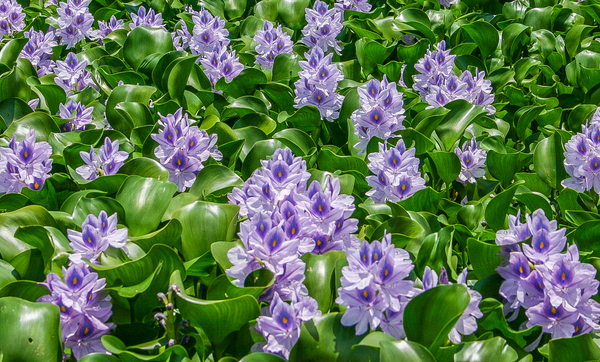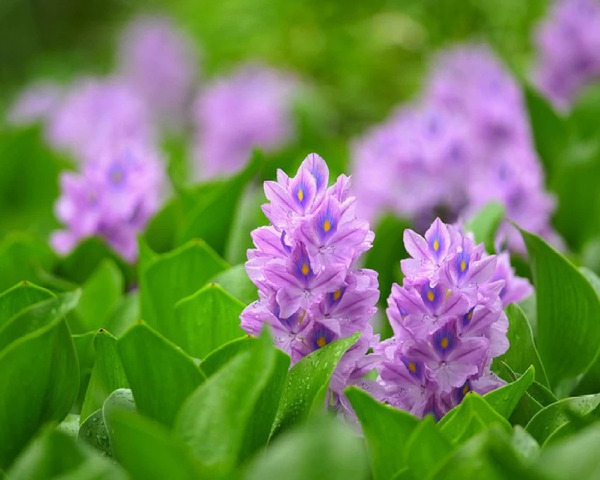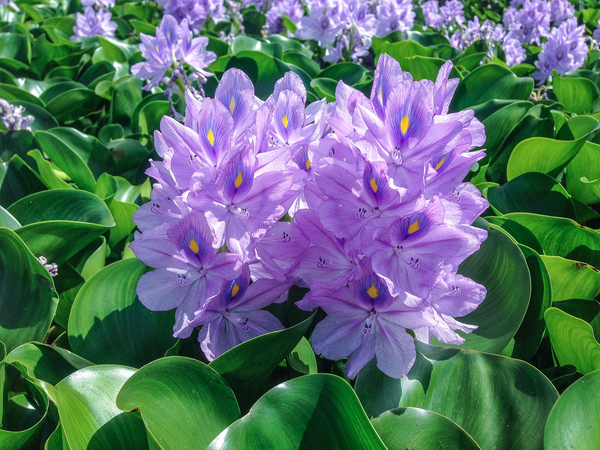When you think of water hyacinth (Pontederia crassipes), the image of its lush green leaves and charming blue-purple flowers might come to mind—a floating jewel of any water body. But behind its gentle appearance lies a serious problem: water hyacinth is one of the world's most aggressive invasive species, often referred to as the "green monster" of water systems. This plant’s ability to thrive and dominate has made it both a wonder and a headache for ecologists and governments alike. Let’s dive into how this aquatic beauty turned into an environmental villain.

Originally native to the Amazon Basin in South America, water hyacinth was introduced to many parts of the world for its ornamental beauty. But it quickly revealed its wild side with a series of invasive tactics:
Explosive Growth:
Water hyacinth grows at an astonishing rate. Under optimal conditions, its population can double within two weeks. This rapid growth allows it to blanket entire water surfaces in no time.
Unstoppable Spread:
Its buoyant structure—thanks to bulbous air sacs under its leaves—lets it drift effortlessly across water bodies. Whether in ponds, rivers, or lakes, it moves and multiplies with ease.
Extreme Resilience:
Water hyacinth thrives in a variety of environments, from nutrient-rich ponds to polluted rivers. Its adaptability makes it nearly impossible to contain once it establishes itself.
Ecosystem Disruption:
By forming thick mats on the water’s surface, water hyacinth blocks sunlight from reaching underwater plants. This disrupts the food chain and causes oxygen depletion, leading to the death of fish and other aquatic organisms.
Waterway Blockage:
In regions like Southeast Asia and Africa, water hyacinth has clogged rivers, lakes, and even irrigation canals. This not only hinders transportation but also impairs access to drinking water and irrigation systems.
Breeding Grounds for Pests:
The dense mats of water hyacinth provide a haven for mosquitoes and other pests, increasing the risk of diseases like malaria and dengue fever.
Economic Losses:
Governments spend millions of dollars annually trying to control water hyacinth. For example, in Lake Victoria, Africa’s largest freshwater lake, its spread has severely impacted fisheries and shipping.

Lake Victoria, Africa:
The plant’s rapid growth turned this vital water body into a crisis zone. Fish populations plummeted, and local communities faced immense challenges accessing drinking water and navigating the lake.
China's Southern Regions:
In areas like the Pearl River Delta, water hyacinth has taken over canals and rivers, causing significant economic and ecological damage.
Florida, USA:
In Florida, water hyacinth is considered a noxious weed. Every year, state agencies invest heavily in mechanical removal and herbicide treatments to keep waterways navigable.
Mechanical Removal:
Machines like harvesters or dredgers are used to physically remove water hyacinth. While effective in the short term, this method is labor-intensive and expensive.
Biological Control:
The introduction of natural enemies, like the Neochetina eichhorniae weevil, has shown promise. These insects feed on the plant, slowing its growth and reducing its dominance.
Chemical Control:
Herbicides are used in some areas, but their environmental impact makes this a less favorable option.
Ecological Restoration:
Encouraging the growth of native aquatic plants can help create competition, making it harder for water hyacinth to dominate.

Despite its invasive nature, water hyacinth does have some redeeming qualities:
Water Purification:
Its roots can absorb pollutants like nitrogen and phosphorus, making it useful for treating wastewater.
Fodder and Fertilizer:
After proper processing, water hyacinth can be used as livestock feed or converted into compost.
Industrial Applications:
The plant has potential as a raw material for paper production, biofuel, and even handicrafts.
Water hyacinth is a plant of contrasts: a beauty that can transform into a menace. While it has some potential benefits, its aggressive spread and ecological impacts far outweigh them if left unchecked. The key to managing water hyacinth lies in understanding its behavior and employing a combination of mechanical, biological, and ecological strategies.
This story of water hyacinth serves as a reminder that human intervention in nature often comes with unintended consequences. To coexist with such a powerful plant, we must balance control efforts with innovation and sustainability.
animal tags: Pontederia-crassipes
We created this article in conjunction with AI technology, then made sure it was fact-checked and edited by a Animals Top editor.